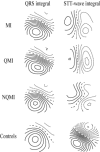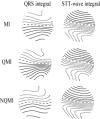Magnetocardiographic assessment of healed myocardial infarction
- PMID: 16846435
- PMCID: PMC6932496
- DOI: 10.1111/j.1542-474X.2006.00106.x
Magnetocardiographic assessment of healed myocardial infarction
Abstract
Background: We evaluated the capability of multichannel magnetocardiography (MCG) to detect healed myocardial infarction (MI).
Methods: Multichannel MCG over frontal chest was recorded at rest in 21 patients with healed MI, detected by cine- and contrast-enhanced magnetic resonance imaging, and in 26 healthy controls. Of the 21 MI patients, 11 had non-Q wave and 10 Q wave MIs. QRS, ST-segment, T wave and ST-T wave integrals, ST-segment and T wave amplitudes, and QRS and ST-T wave magnetic field map orientations were measured.
Results: The MCG repolarization indexes, such as ST segment and ST-T wave integrals, separated the MI group from the controls (ST-T wave integral -1.4 +/- 5.3 vs 1.5 +/- 4.7 pTs, P = 0.034). The abnormalities were more distinct in the Q wave-MI than in the non-Q wave MI subgroup. In the latter, however, a trend similar to the Q wave MI group was found. The relation of QRS area to ST segment and T wave integral improved the detection of healed MIs compared to the ST-T wave indexes alone (QRS-ST-T discordance 14 +/- 10 vs 5.0 +/- 7.1 pTs, P = 0.003). When comparing the MI group to the controls, the orientation of the magnetic field maps differed in the ST-T wave maps (163 +/- 119 degrees vs 58 +/- 17 degrees, P < 0.001) but not in the QRS maps (111 +/- 95 degrees vs 106 +/-93 degrees, P = 0.646).
Conclusions: The MCG repolarization variables can detect healed MI. These ST-T wave abnormalities are more pronounced in patients with Q wave MI than in patients with non-Q wave MIs. Relating the signals of depolarization and repolarization phases improves the detection of healed MI. Repolarization abnormalities are common in healed MI and thus should not always be interpreted as present ongoing ischemia.
Figures




Similar articles
-
Spatial repolarization abnormalities in old myocardial infarction.J Electrocardiol. 2005 Jul;38(3):264-70. doi: 10.1016/j.jelectrocard.2005.03.001. J Electrocardiol. 2005. PMID: 16003714
-
Three-dimensional recovery time dispersion map by 64-channel magnetocardiography may demonstrate the location of a myocardial injury and heterogeneity of repolarization.Int J Cardiovasc Imaging. 2006 Jun-Aug;22(3-4):573-80. doi: 10.1007/s10554-005-9019-x. Epub 2005 Nov 24. Int J Cardiovasc Imaging. 2006. PMID: 16307313
-
Temporal analysis of the depolarization wave of healed myocardial infarction in body surface potential mapping.Ann Noninvasive Electrocardiol. 2004 Jul;9(3):234-42. doi: 10.1111/j.1542-474X.2004.93557.x. Ann Noninvasive Electrocardiol. 2004. PMID: 15245339 Free PMC article.
-
Electrocardiographic signs of remote myocardial infarction.Prog Cardiovasc Dis. 2007 Nov-Dec;50(3):198-208. doi: 10.1016/j.pcad.2007.05.003. Prog Cardiovasc Dis. 2007. PMID: 17976504 Review.
-
Imaging QRS complex and ST segment in myocardial infarction.J Electrocardiol. 2014 Jul-Aug;47(4):438-47. doi: 10.1016/j.jelectrocard.2014.02.004. Epub 2014 Feb 12. J Electrocardiol. 2014. PMID: 24891265 Review.
Cited by
-
Accurate diagnosis of ischemic heart disease without exposure to radiation using non-stress unshielded magnetocardiography.Am Heart J Plus. 2024 Nov 14;49:100483. doi: 10.1016/j.ahjo.2024.100483. eCollection 2025 Jan. Am Heart J Plus. 2024. PMID: 39719971 Free PMC article.
References
-
- Bertrand ME, Simoons ML, Fox KAA, et al Management of acute coronary syndromes in patients presenting without persistent ST‐segment elevation. Eur Heart J 2002;23:1809–1840. - PubMed
-
- Siltanen P. Magnetocardiography In MacFarlane P. (ed.): Comprehensive Electrocardiology, Vol. II New York , Pergamon Press, 1989, pp. 1408–1438.
-
- Nenonen J, Montonen J, Mäkijärvi M. Principles of magnetocardiographic mapping In Shenasa M, Borgreffe M, Breithardt G. (eds.): Cardiac Mapping, 2nd Edition Mount Kisco , NY , Futura Publishing Co., 2002, pp. 119–130.
-
- Brockmeier K, Schmitz L, Chavez JJB, et al Magnetocardiography and 32‐lead potential mapping: Repolarization in normal subjects during pharmacologically induced stress. J Cardiovasc Electrophysiol 1997;8:615–626. - PubMed
MeSH terms
LinkOut - more resources
Full Text Sources
Medical

